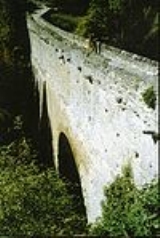
Pont d'Aël
Encyclopedia
The Pont d'Aël is a Roman aqueduct bridge
in the village of the same name, in the comune
of Aymavilles
, in Aosta Valley, Italy
. The bridge, constructed in 3 BC, carried water for the agricultural lands of the newly founded colony
Augusta Prætoria Salassorum (today: Aosta
) across a side valley, 66 m above the bottom. It belonged to a sophisticated, 6 km long aqueduct, running along the steep cliffs of the valley. The originally three-story structure featured a roofed control corridor; notably, it was privately financed. Today, the Pont d'Aël carries a hiking trail.
Besides the Pont d'Aël, two other Roman bridges in the Aosta valley are still intact: the Pont-Saint-Martin in the town of the same name and the Pont de Pierre
in Aosta
.
Completed:
Roman aqueduct
The Romans constructed numerous aqueducts to serve any large city in their empire, as well as many small towns and industrial sites. The city of Rome had the largest concentration of aqueducts, with water being supplied by eleven aqueducts constructed over a period of about 500 years...
in the village of the same name, in the comune
Comune
In Italy, the comune is the basic administrative division, and may be properly approximated in casual speech by the English word township or municipality.-Importance and function:...
of Aymavilles
Aymavilles
Aymavilles is a town and comune in the Aosta Valley region of north-western Italy.The Roman aqueduct bridge Pont d'Aël, in the village of the same name, crosses a 66 m deep gorge, today carrying a hiking trail....
, in Aosta Valley, Italy
Italy
Italy , officially the Italian Republic languages]] under the European Charter for Regional or Minority Languages. In each of these, Italy's official name is as follows:;;;;;;;;), is a unitary parliamentary republic in South-Central Europe. To the north it borders France, Switzerland, Austria and...
. The bridge, constructed in 3 BC, carried water for the agricultural lands of the newly founded colony
Colonia (Roman)
A Roman colonia was originally a Roman outpost established in conquered territory to secure it. Eventually, however, the term came to denote the highest status of Roman city.-History:...
Augusta Prætoria Salassorum (today: Aosta
Aosta
Aosta is the principal city of the bilingual Aosta Valley in the Italian Alps, north-northwest of Turin. It is situated near the Italian entrance of the Mont Blanc Tunnel, at the confluence of the Buthier and the Dora Baltea, and at the junction of the Great and Little St. Bernard routes...
) across a side valley, 66 m above the bottom. It belonged to a sophisticated, 6 km long aqueduct, running along the steep cliffs of the valley. The originally three-story structure featured a roofed control corridor; notably, it was privately financed. Today, the Pont d'Aël carries a hiking trail.
Besides the Pont d'Aël, two other Roman bridges in the Aosta valley are still intact: the Pont-Saint-Martin in the town of the same name and the Pont de Pierre
Pont de Pierre (Aosta)
The Pont de Pierre , meaning "Stone Bridge", is a Roman segmental arch bridge in the Italian city of Aosta in the Aosta Valley. The bridge crossed the Buthier about 600 m from the eastern exit of the Roman colony Augusta Praetoria; in later times the torrente changed its course, leaving the...
in Aosta
Aosta
Aosta is the principal city of the bilingual Aosta Valley in the Italian Alps, north-northwest of Turin. It is situated near the Italian entrance of the Mont Blanc Tunnel, at the confluence of the Buthier and the Dora Baltea, and at the junction of the Great and Little St. Bernard routes...
.
Bridge inscription
- IMP CAESARE AVGVSTO XIII COS DESIG
- C AVILLIVS C F CAIMVS PATAVINVS
- PRIVATVM
Completed:
- Imperatore Caesare Augusto XIII consule designato
- Gaius Avillius Gaii filius Caimus Patavinus
- privatum
See also
- Roman bridgeRoman bridgeRoman bridges, built by ancient Romans, were the first large and lasting bridges built. Roman bridges were built with stone and had the arch as its basic structure....
- List of Roman bridges
- Roman architectureRoman architectureAncient Roman architecture adopted certain aspects of Ancient Greek architecture, creating a new architectural style. The Romans were indebted to their Etruscan neighbors and forefathers who supplied them with a wealth of knowledge essential for future architectural solutions, such as hydraulics...
- Roman engineeringRoman engineeringRomans are famous for their advanced engineering accomplishments, although some of their own inventions were improvements on older ideas, concepts and inventions. Technology for bringing running water into cities was developed in the east, but transformed by the Romans into a technology...

